by Winding Pathways | Jun 27, 2024 | Nature, Trees/Shrubs
This is a story of the serendipity of giant trees. On a recent long drive to New Jersey, we planned to visit a grove of giant white pine trees in Pennsylvania’s Cook Forest State Park. Plans don’t always go perfectly, but sometimes serendipity happens. It sure did for us.
We are awestruck by the beauty and heritage of giant trees and found an exceptional one by accident. Serendipity. About a hundred miles after we left home, we needed to change drivers and exited Interstate 80 Eastbound just after crossing the Mississippi River.
Rest Stop Serendipity
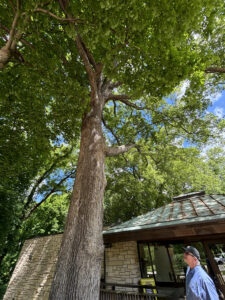
Welcoming Oak
We planned to make a brief stop but stayed a while to marvel at a massive white oak that greeted us at the building’s entrance. We marveled at its girth and spreading limbs. The people who designed and built the restroom structure took pains to carefully craft it to emphasize the tree’s beauty and protect it from construction damage.
This tree is worth a stop. It is at about I-80’s exit one in Illinois immediately south of the Mississippi River. There’s also a magnificent view of the River and Iowa in the distance.
Pennsylvania Wilds Serendipity
We’d checked Pennsylvania’s predicted weather before leaving our Iowa home, and it promised pleasant camping weather in Cook Forest State Park. Our camping gear was in the car as we headed East. Well, weather reports aren’t perfect. Crossing Ohio in driving rain we realized that being in a tent that night would be soggy, but serendipity happened. Our cell phones helped us book an overnight room at a lodge near the Park’s ancient pine grove.
In the rain, we took small twisty roads for about 20 miles north of Clarion, Pennsylvania.
It was still cascading down as we entered the vast park in the midst of THE PENNSYLVANIA WILDS. We’d come a long way and were determined to see the grove of ancients, so, raincoat-clad, we headed up the trail.
Cook State Forest Serendipity
It was magical. We were enveloped in a forest of massive pines that had sprouted around 1600 and bypassed by the loggers who leveled most of the Keystone State’s forests. Beneath the trees, the ground was soft as a plush carpet. Other than raindrops, silence enveloped us – a soothing respite from the Interstate’s noisy trucks.
Cook Forest State Park is set in a vast woodland along the Clarion River. Only a few miles north of Interstate 80, it offers hiking, mountain biking, fishing, hunting, river running, and enjoying massive trees. Many area cabins and lodges offer dry places to overnight, and the Park has a campground. Serendipity met us again.
-
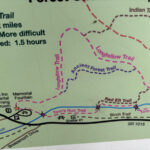
-
Map guidance
-
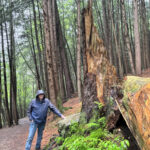
-
Giant forest
-
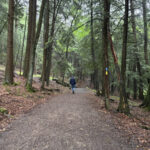
-
Walking in the rain
Clarion River Lodge Serendipity
Wet and soggy after our forest walk, and tired of twisty roads, we found ourselves at the Clarion River Lodge near the grove where Shannon Otte warmly greeted us. She showed us our cozy, dry room. Later we enjoyed dinner while watching the rain continue to drench the woods.
-
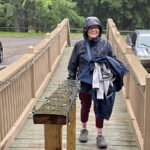
-
We arrived soaked…
-
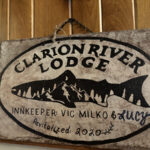
-
Rustic and comfy.
-
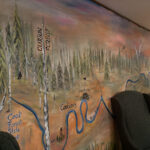
-
One of the warm features of The Clarion Lodge.
Fortunately, the rain slowed, giving us a chance to walk a gravel road above the lodge. Ovenbirds serenaded us from deep in the forest as we overlooked the Clarion River.
The Clarion River Lodge is a revitalized lodge with distinctive rooms creatively well-appointed. The dining area and bar welcome guests and locals. The entire establishment, tucked into the woods is cozy and comfortable. The mix of vintage and modern make for great exploring of the common room and the halls, and peeking into different rooms.
-
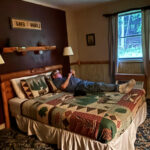
-
Beautiful Quilt
-

-
A blend of old and new.
-

-
The Throwback Record Room
-

-
Light and Airy
The next morning, we took advantage of the coffee maker in the lobby and enjoyed the view of the woods and moss-covered rocks from the end of the second-floor hall porch. A phoebe scolded us as we sat sipping our warm beverage. When we realized we were settled near its nest we moved further away. Under a clear blue sky and waning crescent moon, we enjoyed the soft drip of last night’s rain off the trees.
-
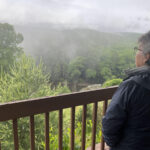
-
Visitors can enjoy several types of lodging in the Pennsylvania Wilds
-
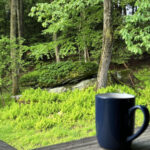
-
A quiet interlude
-
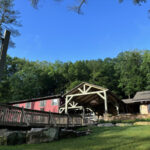
-
Sparkling after the rain.
Overall the drive East was filled with Giant Trees that enticed us to stop.
Finding Giant Trees
American Forests keeps a list of the biggest known individual of nearly all species of North American Trees. The registry helps anyone locate these giant and, often, ancient trees.
by Winding Pathways | Jun 20, 2024 | (Sub)Urban Homesteading, Energy Efficiency, Nature, Trees
Connecting With Wood
Although we rarely watch sports on TV, the 2024 Iowa Women’s Basketball team captivated us. With athletic sneakers squeaking up and down the wood floor, Caitlin Clark’s sharpshooting and Hanna Stuelke’s blocks were amazing.
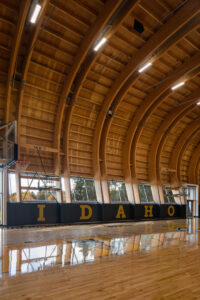
ICCU Arena Photography by Lara Swimmer. Images use restricted. Use by permission only.
About a month after the season, we entered an elite new basketball arena. Neither Caitlin nor Hanna was there, but we bet they’d love playing in a gorgeous new venue crafted mostly of wood. It’s on the University of Idaho campus.
“The arched ceiling beams are strong, beautiful, and crafted of local Douglas Fir and larch,” said Dean of the University’s College of Natural Resources, Dennis Becker, as he guided us through the University’s Idaho Central Credit Union (ICCU) Arena. It opened in October 2021 after about two years of construction and several more of planning and fundraising. Remember, this was during the Pandemic!
Modern, Flexible, and Beautiful Venue
After playing in the nearly century-old Memorial Gym and a few years in the massive Kibbe Football Dome, the University sought to create a gorgeous and flexible venue that enabled players and spectators to enjoy the intimacy of a largely wooden building that connects spectators with nature. Building it drew on the college’s academic strengths in forestry and wood technology, architecture, engineering, and athletics.
“Much of the wood used to create it came from the University’s Experimental Forest. In addition to being elegant its beams of laminated wood are sturdy, fire resistant, and gorgeous,” continued Dean Becker.
-
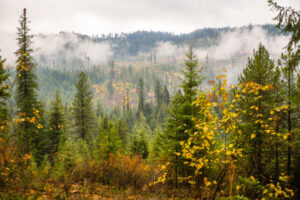
-
Logging and Maintenance at the Experimental Forest
-
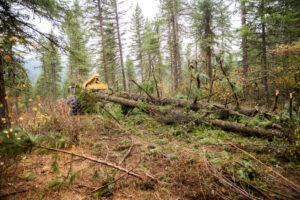
-
Selective logging
The Dean later explained that the reason the building feels warm and comfortable may be a concept expressed by Erich Fromm to describe the biological orientation humans have with all that’s alive and vital. Biophilia was expressed by the late Harvard professor E.O. Wilson as an affiliation people have with other life forms and nature as a whole, which is rooted in our biology.
-
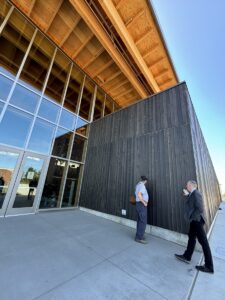
-
Gorgeous and modern
-

-
Courtside in background
-
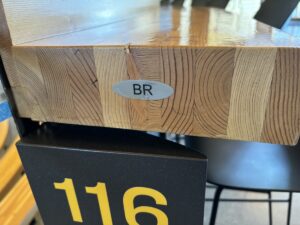
-
Variety of woods
Connecting to Wood
Perhaps biophilia made us feel comfortable immediately after entering the Arena as it does in our Iowa home. In both places, we enjoy being enveloped in wood.
We recently visited friends in their brand-new home. Although functional and low maintenance, something about it was mildly uncomfortable. Crafted almost entirely of human-made products the home had doors of plastic, flooring of artificial planking, and walls of plaster. Even the cabinets were plastic. It lacked wood.
In contrast, our 1947-era home replete with wood feels cozy. Floors are white oak and Douglas fir with beams and rafters of pine, fir, and cedar. Our tables were crafted from red oak and black walnut and on the fireplace mantle is a polished cross-section of an oak crotch and a leaf carved from silver maple wood.
What Is It About Wood?
We love wood. It’s gorgeously individualistic. No two boards are exactly the same. It projects a warm and comforting feeling while having environmental benefits. Sustainably managed forests allow land to continually produce wood forever. It is also easy to reuse or repurpose.
Last winter we hired a company to refurbish our downstairs bathroom of easy-to-clean plastic and vinyl. It functions well, but something about it didn’t feel right. No wood. So, Rich bought a half-inch thick oak board, cut it to fit, finished it with a soft finish, and nailed it to a ceiling beam. That single piece of wood made the bathroom more comfortable.
Whether in a home or the University of Idaho’s Idaho Central Credit Union Arena, the beauty and function of wood make us feel at home.
-
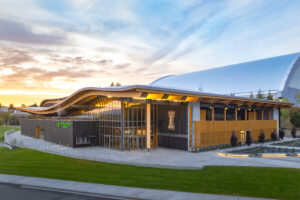
-
ICCU Arena exterior drone shots
-
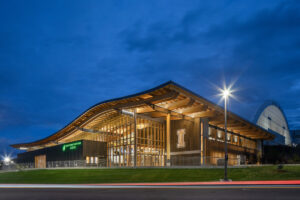
-
ICCU Arena photography by Lara Swimmer. Images use restricted. Use by permission only.
This is one of a three-part series of blogs stemming from a recent visit to our alma mater, the University of Idaho. The school offers an array of majors and is located in the rolling farmland of the Palouse and nestled below Moscow Mountain. For information check out uidaho.edu. Its College of Natural Resources offers majors ranging from wildlife biology to outdoor recreation, and forestry. It’s where Rich graduated. Marion received her MS from the Idaho College of Education, which features a variety of degrees, including movement science.
by Winding Pathways | Jun 13, 2024 | Nature
Smoke Gets In Our Eyes
We sat on our deck on a June 2024 evening and breathed air carrying the season’s first waves of smoke wafting from Canadian fires. Last summer the smoke was so thick visibility shrank to less than a mile. We don’t remember such thick smoke in the past. What’s going on?
-

-
Thick smoke obscures the sun.
-
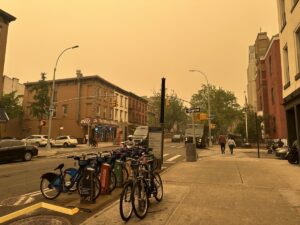
-
Smoke drifts
The answer is. Lots!. Here’s a brief fire history and our half-century involvement with fire and smoke.
Fire’s Cultural History
Indigenous People and Fire
If we sat where our house now stands a thousand years ago, we’d likely have seen smoke. Native Americans routinely set fires that burned through grasslands and forests. Fires transformed the landscape by stimulating grass, killing brush, and favoring fire-resistant plants. In many areas burns prevented the formation of dense woods. Instead, the fire created savannas, widely spaced big trees that towered over soil clothed with grasses, wildflowers, and sedges. These ground-hugging plants nourished bison and elk that provided human food. Shrubs were rare, giving the forest a feeling of “openness”. Fires were an integral part of Native American culture, forming the landscape early Europeans discovered when their sailing ships made landfall.
Europeans and Fire
European culture viewed fire differently. It was considered destructive and wasteful. From early settlement days until relatively recently people eagerly extinguished fires. Aversion to fire became government policy, birthed Smokey Bear, and began the Patterson’s fire journey.
An Idaho Fire
Fifty years ago, Rich was armed with a chainsaw on a high ridge in the Boise National Forest. As fellow crewmates hastily scratched a fire line Rich felled trees downhill toward flames galloping uphill. Hopefully, their fire line would stop the inferno. Help came from above. A noisy slurry bomber dropped fire retardant along the new fire line. It worked! As the fire reached the line it halted.
We were on that smokey ridge because of the Forest Service’s “10 a.m. policy”, which stated that all wildfires would be extinguished by the next morning. The old rule once made sense to a fire-averse culture that didn’t understand fire ecology.
Today’s Wildfires Management
Gradually the science of fire ecology emerged to help us understand the critical role flames play in ecosystem health. The old “10 a.m. rule” is now history, and today’s land managers set prescribed burns. Why?
Well, Rich has personal experience. In 1989 he set a fire in the Indian Creek Nature Center’s oak woodland. “Fire killed understory shrubs of mostly invasive exotic species and stimulated long suppressed sedges, grasses, and wildflowers. After a few years light-demanding young oaks sprouted under the rather open canopy of parent trees.”
How Periodic Fires Help
Periodic fires sort vegetation by retarding plants sensitive to burns while encouraging resistant ones. Low-intensity periodic fires also burn fallen branches and other fuel that, if left unburned, accumulates to enable a future more intensive burn.
-
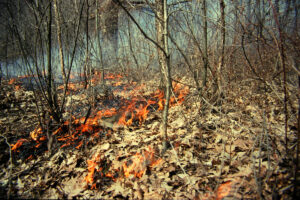
-
Careful burning of woodlands
-
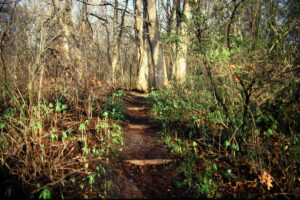
-
Fires help understory
Our Continued Fire Bias
Americans will see examples of fire bias on the nightly TV news this summer. Reporters flock to big fires, especially in the West. They’ll show the charred and smoking remains of a fire and say, “Over 120,000 acres of forest were destroyed this week”. Well, no. Fires, don’t destroy forests. They change and often invigorate them. Fires are a natural form of land disturbance that many plants need to thrive. Journalism fails by not returning to a burn site a few years later to show a verdant growth of new trees…..it’s the rest of the story that many Americans don’t understand.
So Why So Many Fires and So Much Smoke Now
We’re breathing wildfire smoke for two significant reasons. One is our old fire bias.
For a century we’ve done such a good job suppressing fire that forests are choked with dead fallen branches and tangles of small trees that feed hot and intense burns. These hot fires can kill mature trees and spew forth an abundance of smoke. Social bias created these tinderbox woods.
Then there’s climate change. Ecosystems are hotter, dryer, wetter, soggier, and windier. A forest suffering through unprecedented hot drought and overstocked with fuel is a recipe for burns big enough to envelop much of the continent in smoke. According to the University of Idaho’s Dr. Leda N. Kobziar climate change is increasing the availability of fuel, like deep organic soils in northern Canada that now burn.
What is In Smoke?
Is that smoke bad? Well, maybe, and maybe not. Smoking cigarettes causes health issues. Wildfire smoke isn’t as intense or prolonged as that which directly enters the lungs from a cigarette but it can cause breathing problems. Breathing smoky air isn’t healthy.
Research Points the Way
Smoke may have benefits. Dr. Kobziar’s research is investigating the impacts of fire that are beyond the visible. It’s easy to see the physical changes that a burn causes, like Rich’s observation of enhanced wildflower abundance after a burn at the Nature Center. Dr. Kobziar’s team has found that within millions of floating smoke particles is a host of microbes. Microbes! Sounds bad, but these aren’t always tiny creatures that infect people. Smoke transports beneficial microbes that help enhance the health of forest soils but can also move fungi that can infect people. “There’s a lot yet to learn,” said Dr. Kobziar. To read more about this fascinating concept visit.
Managers of grasslands and forests now often set prescribed burns to consume fuel and increase ecosystem health. Normally prescribed burns are held at times and under weather conditions that produce less smoke than wildfires.
-
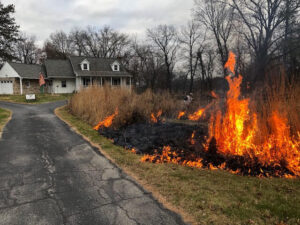
-
Regenerating the labyrinth
-
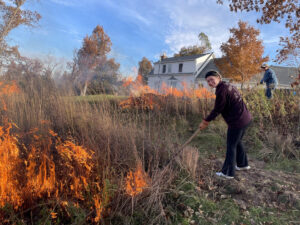
-
workers pull fire along to set other areas ablaze.
-
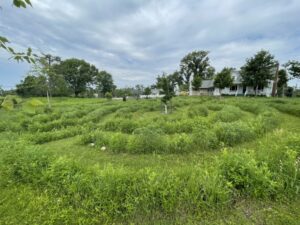
-
Ready for summer’s fullness.
-
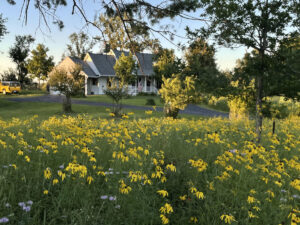
-
Brilliant flowers
Upshot
It looks like we’re up for a smoky summer. It’s understandable why the woods, and even the soil, are burning and spewing forth clouds of smoke.
This is one of three blogs stemming from our recent visit to our alma mater, the University of Idaho. This outstanding college offers, among others, majors in natural science, education, and architecture.
by Winding Pathways | Jun 6, 2024 | (Sub)Urban Homesteading, Nature
Gotta Love Media Hype
Just as the summer camping season began our local newspaper ran a story about dangerous animals. Snakes, bears, and mountain lions. It was scary enough to keep anyone out of the woods or campsite.
Are they really dangerous? Well, we’ve been tromping through woods, deserts, wetlands, canyons, and mountains for nearly 70 years in places where these animals sometimes lurk. Here’s what we have learned and had confirmed by “experts” on how to avoid confrontations with them.
Mountain Lions
Over years of hiking and camping in Idaho, Colorado, Arizona, New Mexico, and South Dakota mountain lion range we’ve never seen one. The odds of encountering a lion are minuscule. If one is around, it’s likely hiding or beating a hasty retreat. People are dangerous, by the way.
According to the Mountain Lion Foundation, the odds of being fatally attacked are about one in a billion, or longer odds than winning a billion-dollar lottery. Still, there have been seven fatal attacks in the past 25 years. Our advice: Odds of seeing a lion are amazingly unlikely but if one is spotted, stay a long way away.
Snake Adventures
We’ve unwittingly walked right past rattlesnakes in South Dakota, Idaho, and Iowa, and once spotted a copperhead near our tent in southern Missouri, but we’ve never been threatened by a poisonous snake. But we have had a few snake adventures.
Little Shovel Gets the Job Done
Once, when our family lived in Florida, Marion’s mom hollered for us kids to get inside. She rarely hollered so we did. Then, she told the older kids to get the neighbor. She had been hanging clothes when a coral snake wandered by. Mom, at all of 4’10” grabbed a huge shovel and pinned the snake in the sandy soil. Our neighbor came over with a little toy shovel, chopped up the snake, and pitched it into the wood pile. The very one where we used to sit in and eat oranges after playing in the orange grove. We found a new place to sit.
Billy Goat Gruff Adventure
When we were new to Iowa Byron Arnold, then a science teacher at Washington High School in Cedar Rapids, took us rattler hunting. Just to see them, not to hurt them. Byron and Rich took off with long strides while Marion, with shorter legs, and curiosity about the emerging wildflowers lingered. Realizing she’d lost sight of the guys, she hopped onto a large flat rock to be greeted in “Billy Goat Gruff” style by a timber rattler underneath inquiring, “Who’s that walking on my rock roof?” Yipes! Now what? Backing up to the far edge, she used her best movement science technique of the running LONG jump off the rock and sprinted across the stone-littered open woods. BTW, the guys had walked right past that rock and never disturbed the gentlemanly timber rattler.
Aptly Named Park In South Dakota
When camping at Snake Creek Campground in South Dakota on a boiling hot summer day, we decided to walk widely mowed paths to the beach. The name of the park is aptly named. Usually, we walk side by side. That day we were going single file when Marion spotted an unusual shape on the edge of the path. A prairie rattler is known to be mean. She called to Rich to watch out. He then stepped closer for a better look. GAAK! The snake kindly retreated. We took the long road back to the tent and slept uneasily that night.
Stay Away From the Sharp End
At an Outdoor Writers Conference years ago, a dog handler who trains hunting dogs to stay away from the sharp end of the snake calculated that for every snake people actually see on a ramble, they have likely passed dozens of unseen snakes over their hiking years. Snakes avoid confrontation. Because people are dangerous!
Snake Facts
According to the University of Florida, the odds of being bitten are about one in 37,500. The chart on the webpage reveals the thousands of people who die from lung cancer and auto accidents. But people still smoke or live in polluted areas and drive cars. So why are we freaked about snakes? Publicity.
With modern antivenoms, very few people die of snakebite. Most bites occur when people handle or molest a snake. Our advice: Watch where you step or put your hands (i.e. if rock climbing in snake country). If you spot a snake, stay away from it. Never attempt to irritate it or pick one up.
Bear Stories
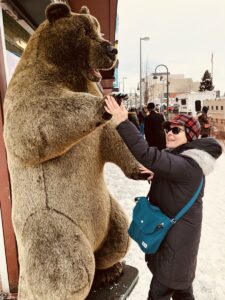
Close up with bears
Now, Bears are a different story. They range through most of the country but usually stay out of sight and away from people. And there are exceptions. Rich’s cousins tell a hilarious story of a bear climbing into the New Jersey suburban home, helping itself to kitchen goodies, and leaving its paw print on the wall as it left, all while the cousin and aunt huddled in the bedroom. Where was their cell phone? In the kitchen!
Friends of Marion’s in New Hampshire have bear adventures we’ve blogged about on Winding Pathways. And, in suburban New Jersey bears are routinely sighted at Cedar Lake. Marion has not been fortunate to see one, because she always smokes a stinky cigar from Denville Smoke Shop – obviously, this tactic works as bear repellent.
But, bears ARE around in suburban areas.
-
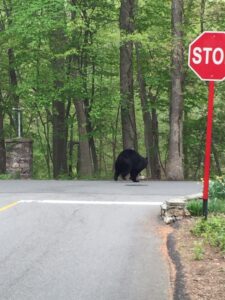
-
Suburban NJ has some prolific and big bears.
-

-
Picket fence torn apart by a hungry spring-time bear.
-
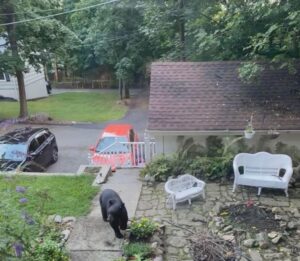
-
Bears make themselves at home anywhere.
Bear Facts
According to the National Park Service, the odds of a park visitor being attacked by a bear are one in 2.7 million. They are spreading and can cause mischief. Our advice: Keep a clean camp. Never leave food or other alluring objects with aromas (toothpaste, deodorant, perfumes in a tent. {why would one use any of these on a camp trip, anyway?} If a bear is spotted, stay a long way away, make noise, and slowly walk away from the animal.
What Animals Are Dangerous?
The best way to avoid trouble with any wild animal is to keep your eyes open and avoid conflict by staying a long way away.
Lions, snakes, and bears aren’t terribly dangerous but some animals are. Worldwide the most dangerous wild animal by far is the mosquito! According to the Advocates Injury Attorneys, the animals most likely to kill someone in the United States in order are:
- People. Homicides.
- Dogs.
- Deer. They don’t attack people. Deaths result from collisions with cars.
- Horses and Cows
- Bees, hornets, and wasps
At Winding Pathways, we encourage people to camp, hike, and enjoy the outdoors in their yards. Dangerous animals are not so abundant.
Threats posed by mountain lions, bears, and snakes are tiny and many can be prevented by using caution and common sense. Be cautious but go outside and PLAY!
by Winding Pathways | May 23, 2024 | Nature, Reflections/Profiles
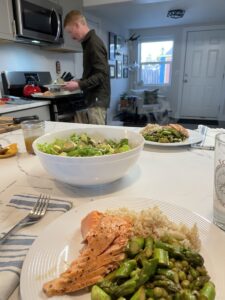
Salmon is delicious and healthy.
On an April morning, we discovered three fish that had spent their lives circling the North Pacific Ocean on our porch in Iowa. Three delicious sockeye salmon landed on our porch. We quickly converted them to delicious meals.
How’s that possible?
Back In Time
The story goes back to 1971 when Rich was a biologist working for the Alaska Department of Fish and Game. “For days the Ugashik River seemed empty of salmon. Then I glanced downstream to see an immense swarm of bright red fish heading my way.” It was the first wave of hundreds of sockeyes that passed by that summer to ascend tributaries to spawn and die.
What Sockeye Salmon Eat
Unlike other salmon species that mostly eat small fish, crabs, and squid, small sockeyes, called smolts, leave freshwater and spend a year, sometimes two years, circling the ocean with their mouths open. They strain zooplankton from the water. Many of these tiny animals are reddish and the color permeates the flesh of Sockeyes, sometimes called Red Salmon.
During his years in Alaska Rich had the chance to eat many fish species, but the Sockeye was his favorite. “They’re delicious, perhaps because they eat low on the food chain. This also keeps them relatively free of contaminants common in other species. I can eat Sockeye without guilt. Thanks to excellent management millions of them swim in the ocean. Biologists make sure that plenty survive fishing nets to ascend rivers to spawn. In recent years Sockeyes have increased,” he said.
Where Get Sockeye Salmon?
Although Sockeye’s are delicious and abundant it’s hard to buy frozen fillets in Iowa.
The Popsie Fish Company solved the problem. The box we found on our porch contained six frozen fillets of Sockeyes caught near Egegik, Alaska.
“We’re beach netters. We stretch gill nets from the beach out into Bristol Bay. Sockeye get tangled in the nets. When the tide goes down, we take the fish from the nets, and fillet and freeze them. Then we ship them everywhere to customers like Rich and Marion Patterson, “said Tony Neal, owner.
These fish are caught and processed right here in the United States.
-
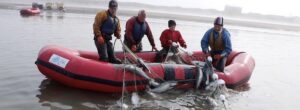
-
Gill netting
-
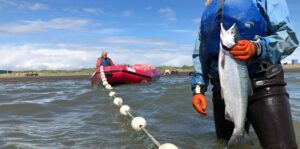
-
A freshly caught sockeye salmon.
Expensive. It costs about $250 to have ten pounds of fillets sent to our home, but prime beef cuts purchased locally cost about the same, and finding quality fish locally is not easy. All Sockeye salmon sold are wild fish that spent their lives freely swimming in the ocean. That contrasts with today’s beef, pork, chicken, and Atlantic salmon which are crammed together and totally confined.
What is “Atlantic Salmon?”
Any fish marked “Atlantic Salmon” came from a fish factory farm with thousands of fish confined in a huge tank or pen in the ocean. They’re fed a concentrated human-created diet and never have the chance to swim freely in the ocean. They may contain antibiotics.
When in the grocery store look closely at a package of frozen fish that says, “Wild Alaskan” on the label. In fine print it probably says a product of China. Yup, many fish are caught in Alaska, frozen, shipped to China for processing, and refrozen. They are then sent across the ocean and land to the grocery store. Quality suffers.
We love fish and whenever we’re down to the last frozen fillet of Popsie Fish Company’s Sockeye we’ll put in an order for another box to appear on our porch.
A Quick Guide to Salmon
Found in Groceries
Pink Salmon. The most abundant and smallest species of Pacific salmon. Usually the least expensive. Caught in nets.
Coho or Silver Salmon. Normally the latest run of all salmon and available fresh in late summer. Caught in nets and by hook and line. Some are farmed.
King or Chinook Salmon. The largest salmon species and hard to find in the store. Mostly wild caught but some are farmed in New Zealand.
Chum or Dog Salmon. A medium-sized fish usually fairly low-priced and wild-caught.
Sockeye Salmon. The tastiest salmon according to Rich. Always wild and net-capted.
Atlantic Salmon. Not a salmon at all but in a different genus. All Atlantic Salmon on the market are farmed, mostly in Canada, Norway, or Chile.
-
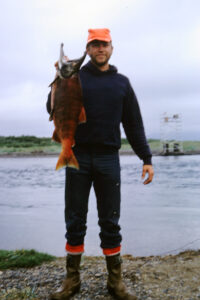
-
Good Catch
-
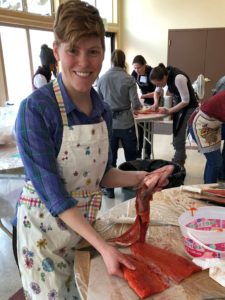
-
Filleting salmon.
-
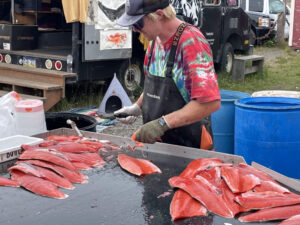
-
Processing salmon
by Winding Pathways | May 9, 2024 | (Sub)Urban Homesteading, Foraging, Nature
Serendipity
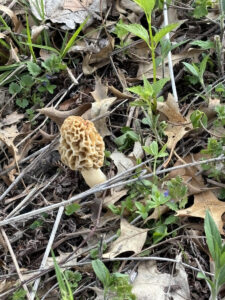
Morels appear like magic.
A surprise morel mushroom sighting was a serendipitous find for Marion. It happened on May Day 2024, in an area of Winding Pathways we’re rewilding. While seeking blooming bluebells and emerging May Apples she spotted the delicious fungus poking through last year’s oak leaves. We’ve since found more. With Cedar Rapids Houby Days just around the corner it looks like a good season for morels.
We own about two acres. Our house, garden, and lawn occupy about half our land. The rest we’re gradually rewilding to its native vegetation. Although we sometimes discover vegetative surprises in our unsprayed lawn, the most delightful new plants appear in our property’s “back 40”.
Nature’s Resiliency
Newly emerging species remind us of nature’s resiliency. A few years ago, a derecho’s 140-mile-an-hour wind knocked down many of our mature trees. Much of our land was shady, but the 40-minute storm transformed it into a sunny landscape. We’ve since noticed a dramatic decline in shade-loving ferns and an increase in sun-loving Wing stem. Other plants are fading and rising as the years go by.
We recently read that archeologists had found 4,000-year-old mullein seeds in an Egyptian tomb. When planted, they sprouted! Lots of native plants may not have the ability to stay viable that long, but they remain down in the soil, perhaps for decades, waiting for the right ecological conditions. Then they rise as if by magic. Other plants can spread their seed widely. Ones that end up in just the right place also sprout seemingly magically.
Pause for Thought
Ecological mysteries give us pause for thought and reasons to marvel at nature’s resiliency. We don’t know if our morels had been in the soil for years or if a spore had landed there more recently. Either way, this spring brought perfect conditions for their growth, and they appeared.
Enjoying Nature’s Abundance
We carefully picked our mushrooms, consulted with an experienced neighbor, and enjoyed them after preparing them and simmering in butter.
We’ll keep watching for others to appear.
Where Do Morels Grow?
Morels live across the country and usually appear in April or May. Hunting them is a popular activity. For information check these websites
Rewilding Winding Pathways
We’re gradually rewilding about an acre of Winding Pathways. Although many believe this simply means “letting nature take its course” we know that’s not feasible today because so many invasive species stress native plants. We manage nature lightly as we rewild our land. Here’s what we do.
- Remove the worst invasive species including Japanese Barberry, Asian Honeysuckle, Multiflora Rose, and Asian Bittersweet. As soon as we spot one, we unleash the lopping shears and chop it off as close to the ground as possible.
- Replaced three areas of lawn with native prairie.
- Carefully use prescribed burns to encourage natives and discourage invasives.
Natural or Native is Not Always Desirable
Two native species belong in our rewilding areas, but we discourage them because of the misery they can cause. We just keep them away from pathways. Here are the culprits:
Poison Ivy: It’s an important and valuable native plant for wildlife. Poison Ivy’s early spring leaves are an almost iridescent red, and they glow bright red in autumn’s fading days. Birds and deer devour the berries. Cottontails love eating the foliage and stems. All good except the itching. Both Marion and Rich are allergic to it and don’t enjoy the awful rashes that result from close encounters. We stay away from poison ivy and don’t cut it but spot-spray those plants growing close to pathways.
Virginia Tickseed: This interesting native doesn’t seem to be used much by wildlife, and it’s rather attractive. Come fall it produces zillions of small burs that are nearly impossible to remove from our clothes. We chop off any we find growing close to paths.
-
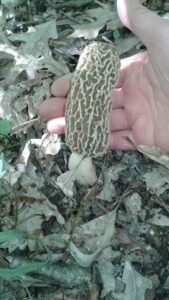
-
Morels’ distinctive shape. Credit Fitzgibbons
-
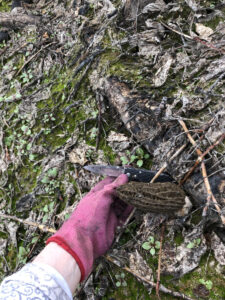
-
Carefully cut or break off a morel. Credit Fitzgibbons
Finding morels was exciting. We’ll likely find plants new to us springing up in our wilder areas. Most won’t be edible like morels, but they are fascinating and are living examples of nature’s resiliency.











































